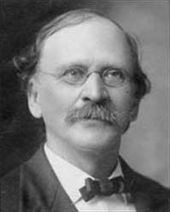Edward W. Morley
Edward Williams Morley (born January 29, 1838 in Newark , New Jersey , † February 24, 1923 in West Hartford , Connecticut ) was an American chemist .
Edward Morley grew up as the son of a Congregational clergyman in West Hartford, where he returned after his retirement. He graduated from Williams College in 1860 . He then attended a theological seminar and was in the medical commission of the northern states in the last year of the civil war . He then taught at the South Berkshire Institute in Massachusetts . Morley was versatile (also musically and linguistically), taught himself many subjects such as mathematics and medicine and taught in many subjects; he was also a very skilled craftsman. His only advanced degrees were honorary degrees (an MD in Medicine from Cleveland Medical College and a Ph.D. from Wooster College). In 1868 he was appointed to head the Congregationalist Church in Twinsburg , Ohio , but a little later instead took the opportunity to teach at the Western Reserve College (later Case Western Reserve University ) in Hudson (geology, chemistry, natural sciences, mathematics). The college moved 50 kilometers north to Cleveland in 1882 . He stayed there until his retirement in 1906. Morley was known as a skilled experimenter.
The best-known of his work is the Michelson-Morley experiment , which he carried out in 1887 together with Albert A. Michelson . Neither he nor Michelson accepted that it refuted the light ether theory . In retrospect, however, the experiment was seen as evidence of Einstein's special theory of relativity from 1905. Together with Dayton C. Miller , he carried out several repetitions of the experiment from 1902 to 1905, which again yielded negative results.
It is also known for its exact determination of the ratio of the molecular weights of oxygen to hydrogen (it received the value 15.879 - close to the value accepted today of 15.8729), published in 1895. It is considered the high point of molecular mass determination with "wet chemistry" and exceeded in accuracy (he used three different methods) that of all his contemporaries.
Morley also worked on the chemical composition of the Earth's atmosphere , thermal expansion, and the speed of light in a magnetic field .
In 1892 he was elected to the American Academy of Arts and Sciences , in 1897 to the National Academy of Sciences and in 1903 to the American Philosophical Society . In 1907 he received the Davy Medal of the Royal Society . He was president of the American Association for the Advancement of Science . The lunar crater Morley is named after him.
Morley was married but had no children.
literature
- Ralph Hamerla: An American Scientist on the Research Frontier: Edward Morley, Community, and Radical Ideas in Nineteenth-Century Science , Archimedes: New Studies in the History and Philosophy of Science and Technology 13, Springer 2006
Web links
Individual evidence
- ^ Morley, On the Densities of Hydrogen and Oxygen and on the Ratio of Their Atomic Weights, Smithsonian Institution Contributions to Knowledge, no.980, 1895, shorter versions published in the American Chemical Journal, Proc. American Association for the Advancement of Science and the Journal of Physical Chemistry
| personal data | |
|---|---|
| SURNAME | Morley, Edward W. |
| ALTERNATIVE NAMES | Morley, Edward Williams |
| BRIEF DESCRIPTION | American chemist |
| DATE OF BIRTH | January 29, 1838 |
| PLACE OF BIRTH | Newark , New Jersey |
| DATE OF DEATH | February 24, 1923 |
| Place of death | West Hartford , Connecticut |
